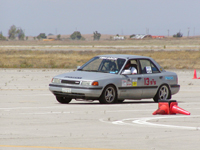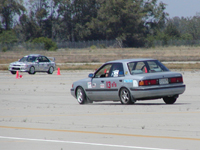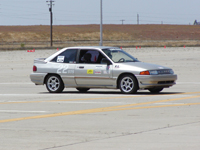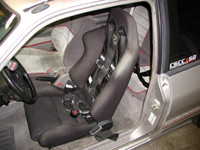Both these cars share the same basic platform structure, with the Protege assembled in Japan and the Escort largely assembled in Michigan and Mexico. In fact, the 1.8-liter 4-cylinder is the same, as is the 5-speed transmission, and numerous suspension and braking system components. David and Will share information too, since they both compete at Cal Club autocross events in SCCA's immensely popular Street Touring S class.
This year they are both proving what their potent little twins can do on the national scene too, competing at select West Coast National Tour and ProSolo events. Having already earned trophies for their efforts, David and Will hope to keep fellow STS racers honest for the rest of the year, by continuing to push for quicker times and event wins.
Family Resemblance, Technically Speaking
The Mazda-sourced powerplant has proven to be a popular little mill with Mazda and Ford over the years, finding a home in the Mazda Protege, Ford Escort GT, Mercury Tracer LTS, Kia Sephia GS, and even under the flowing hood of Mazda's zoomy little Miata roadster. There were a few small detail changes over the course of the engine's life, but its overall structure remained intact.
Based on a robust cast-iron block, the BP18 is topped with an aluminum cylinder head featuring twin camshafts and 16 valves. Cylinders measure 83mm diameter in bore, with an 85mm stroke, giving strong mid range punch for coming out of tight corners. Power is rated at 125hp in the Protˇgˇ with 114 ft-lbs of torque, while the Escort was rated at 127hp in GT trim.
Underneath these common chassis lies a four-wheel independent suspension that uses MacPherson struts up front and Chapman struts in the rear. Stock spring rates and anti-roll bar diameters are suited better for daily driving than autocrossing, but both the Protege and Escort GT are known for having excellent balance. Disc brakes that provide strong stopping power are mounted at all four corners. Often under estimated, these little machines can be real giant killers, especially when they are setup and driven by the likes of Will and David.
David and His Ride
David's Protege has been the only autocross machine he has driven full-time in the nearly 12 years he has been racing. He's driven other cars at major events, like Steve Wynne's STS Neon, Will's Escort GT, and Don Green's Acura Integra - to an impressive ProSolo win in 1997 in fact - but David's true genius lies in the fact that he has fine-tuned his cars setup, and can make it work at just about every event and surface.
David admits to taking things slow when it comes to car preparation. "I don't make many changes to the car" he says, "I prefer a car that doesn't take much tweaking to make it work." It must be working, because over the past couple years David has put his Protege on the podium at several events, including wins at the 2000 San Diego NT and 1999 Seattle NT. David has been fast this year to, with a fourth at this year's Atwater National Tour.
Taking him to all these top-placed finishes is David's trusty silver Protege. Starting off under hood, David has made only minor upgrades, such as the K&N air filter in the stock filter housing. "Most of the intakes sacrifice torque" according to David, "besides, the stock VAF is restrictive enough to limit anything you might do with intake piping." Living in California also provides some problems for David, as he has had difficulty finding CARB-approved headers for the Protege.
Focusing on the suspension instead, David has recently upgraded the front with camber plates, which allows for 2.5-degrees of negative camber in race trim. "I've only had a couple events on them, so I'm still learning." Admits David. Alignment is set at zero toe both front and rear, and David estimates front caster to be somewhere around 4 to 5 degrees.
Mounting to those camber plates are Mazdaspeed adjustable struts, which feature valving originally designed for the Mazda MX-3 (which are about 10-15% stiffer in both rebound and compression than the Protege units.) Modified DSS coil-over kits mount over the struts, and David uses long 12-inch front springs rated at 250 lbs/in, with 8-inch springs in the back rated at 200 lbs/in. "The longer springs in front help keep them from rattling around." according to David, "But in the rear, tire clearance limits you to shorter 8-inch springs, so tender springs are a good idea to limit the clunking on the street."
A Suspension Techniques 3/4-inch diameter anti-roll bar is added to the stock bar up front, while a 1-inch diameter anti-roll bar from Compass Motorsports is used in the back, helping to stiffen up the rear and provide a more neutral balance. David warns that the stock anti-roll bar mounts aren't up to the task of supporting the loads generated by the bigger bars, so it is good to routinely check them and repair when necessary.
The current STS tire of choice is the Falken Azenis RS, and David was one of the first to try out these sticky street tires early last year. He runs 205/50-15 Azenis on 15x7.0-inch Enkei RP-01 wheels, which really fit the Protege's somewhat chunky nature. "For the price, I figured the Azenis were hard to beat, and the hundreds of other autocrossers using them seem to agree."
Besides his Protege, David has another competitive edge, in the form of his co-driver - and girl friend - Julie Jacobs. Julie is as fast as they get out on track, and has earned herself several trophies over the years too, including a second in STSL - just 0.002 seconds off the win - at this year's Atwater National Tour.
For David, autocrossing isn't just about the competition. "Sure, I like to be competitive, but it's the friendships and socializing at events that make them fun." And fun is one thing that everyone will have when David and Julie arrive in their little Protege. Except maybe for David's competition, when they see him take home another trophy.
Will and His Hot GT
Will Kalman has been a real revelation on the STS scene in 2002. New to autocross - having only competed since 2000 - Will's commitment and excellent driving early in the year have seen him come away with STS class wins at the San Diego NT, El Toro ProSolo, and Atwater NT. He also finished second at the Atwater ProSolo, giving him a strong jump on the season. Not a bad way to open up his first season of national level competition, especially when you consider he did all this in a "one-wheel" drive Ford Escort GT.
Will's 1991 Ford Escort GT shares quite a few components and setup techniques with David's Protˇgˇ, including the relatively mild level of engine preparation. Besides the K&N air filter in a modified stock air box, Will has bolted on a ceramic coated Pace Setter Header and a Millen cat-back exhaust.
Underneath the Escort, Will has fit Mazdaspeed 4-way adjustable struts that are modified to carry coil-over kits originally designed by Joe Graves, that incorporate components from Ground Control and True Choice. These kits accept DSS 2.5-inch diameter springs, and Will has selected 250 pound springs for the front, and 200-pound springs for the rear. Thanks to adjustable front camber/caster plates, Will runs 2.25-degree negative camber, with the caster maxed out. "The extra caster is dialed in to give it more effective negative camber in the sharper turns where the car would tend to push" according to Will.
A 3/4-inch diameter Suspension Techniques front anti-roll bar is added to the stock bar, while a large 1-inch diameter rear bar is sourced from Compass Motorsports. The chassis is stiffened up with a front tower strut brace made by GAB, and a lower front tie bar from Corksport, and a Mazdaspeed rear strut tower bar. Keeping the chassis stiff and eliminating any flexing goes a long way toward improving the feel from both ends of the car.
Will's hot Escort is also running on the STS tire of choice, the Falken Azenis. Their wide 205/50-15 tire fits nicely on a set of 15x7-inch Kosei K-1 wheels for track use. For the street, a set of stylish 16x7-inch Technomagnesio TM Sport wheels get wrapped with Kumho 712 tires. Holding him in place during all those high g-load transitions is a Corbeau Targa RS seat, which according to STS rules features a reclinable seat back.
All of those trick parts aside, the most amazing thing about Will's performance this year is that it is based off a calculated approach to car tuning that differs from what most newcomers to the sport often think is important. He wasn't going for peak power or worrying about getting the biggest tire under the fenders. Instead "My goals were to make the car rotate readily, put power down exiting turns, and most importantly, make the car predictable" explains Will.
His techniques must be working, because Will has the eye of every top STS competitor aimed squarely on him for the rest of the year. Fortunately for the competition, Will won't be able to take a stab at running for the ProSolo or National Championship this year. He has something more important to do in September, or should I say due, as he and his wife are expecting twins. Some things are more important than racing after all.




